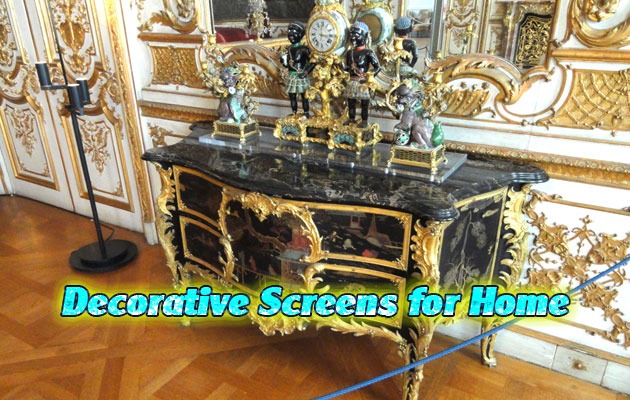Decorative screens have been around since ancient times in China. It has spread throughout East Asia until it has reached the West and all over the world. They have remained popular since then, as they were designed to part a space into two, but now they have many different purposes.
There are many different varieties of screens made up of different materials to suit any interior and exterior home designs. But these are perhaps the main classifications of screens:
1. Free-standing screens
It includes foldable, moveable and flexible types with wide-ranged styles including Shoji, Moroccan, and French. Most Asian-style screens are free-standing – they are flexible and are often made of brass, bamboo, pine, wicker, rice paper, and rattan. These are also adopted in the West and are available in different designs and materials suited to their tastes. Modern free-standing screens are usually made of digitally printed canvas, which brings color and pattern to a room.
 2. Installed screens
2. Installed screens
These are permanently installed in the house, including wall screens, metal screen panels, folding glass, and louvered doors. Some sliding doors are also considered as installed screens. These types are usually placed on an exterior setting in the home. The usually installed screens are decorative metal screen panels, or perforated metal panels, because they work well with most interior styles, like classic, contemporary, country, industrial, rustic and more.
In choosing any type of screen, you have to make sure of its quality. Perhaps you might just want to accessorize your home, but remember that compromising quality for budget may not give you the overall impression you want to achieve. Also, determine where and how you would use the screen, as well as some family considerations. For instance, if you’re a mother of small kids and you want a screen between the living room and the den, don’t pick a Shoji screen – it’s too delicate for a home with children running around. Click the link to contact expert professionals when it comes to decorative panel solutions.
Besides decorating a space, here are some functions and tips on using the two types of screens:
Free-standing screen
1. Use it as a room or space divider.
Do you have a large bedroom that you wish you can divide to create a designated space for something else, like for doing arts and crafts or a reading nook? Using a decorative screen can do it, plus you would get a completely new look. Its versatility allows you to change its position anytime, anywhere.
2. Create office space.
So you’re a work-at-home mom. You may want to separate your personal space from your professional space, but building a wall might seem too much. Putting up a decorative screen and setting up your work table and chair on the other side can do the trick while creating a decoration out of it.
3. Make private areas.
Put up a screen for your guest room so those sharing a room can feel more comfortable dressing up. It’s also great for making a dedicated space for meditation, relaxation or for private conversations. It also helps create a decorative touch to any space.
4. Hide any portion of a room.
No matter how much admirable your interior design is, the view would always be ruined by clutter. Did your little toddler draw a dinosaur on your white wall? Put up a screen and decorate. Do you have unorganized cleaning materials under the stairs? Put up a screen and decorate. Is your TV area full of an electronic mess because of too many cords and consoles? Put up a screen and decorate. A decorative screen is pretty much your concealer, home-wise.
5. Add a statement to your home.
A plain wall can be made more interesting if you would add a screen, and then put up some huge porcelain pieces or tall flower vases in front of it. That makes a great statement piece, especially if your house lacks a fireplace. It can also draw attention to your favorite piece of furniture, couch or chair by placing a screen behind it, making it a major focal point in a room.
6. Give some shade to your patio.
If you love hanging out on your patio but hate the direct sunlight that goes through it, you can diffuse light and provide a lovely shade by positioning a screen against the direction of the light. However, take note that a wooden screen might change colors after a period of time due to exposure to sunlight.
7. Utilize light.
Do you love decorating with light? An empty corner can be beautifully decorated by putting up an upward facing light and then placing a decorative screen in front of it. You may add a potted plant on the other side, and you have created a work of art.
Installed screens
1. Use it as a substitute for your fence.
A fence or gate wall marks your territory. Define it in style by placing a metal screen panel with a pattern of choice to create an outdoor statement.
2. Add privacy.
Contemporary homes with glass walls can make use of laser-cut decorative metal screen panels to add privacy. Gardens can also make use of these so as to block the view from the interior of a home. These screens may look fragile because of their thinness, but they are actually durable because they are made of metal. It also creates a sense of elegance and uniqueness to the façade of any home by making a delicate feel.
3. Use it as a room divider or as cover to patio.
Open plan living rooms can utilize an installed screen as a space divider, while patios can be covered by a screen. You may use either a metal panel or a glass. An etched glass screen can make an elegant division on your kitchen and dining area, while a perforated metal screen blends well with a pergola above your patio.


